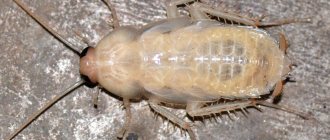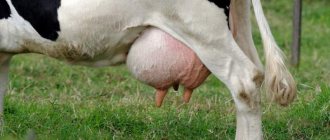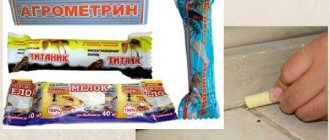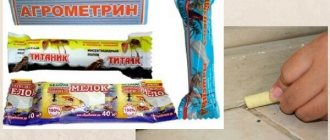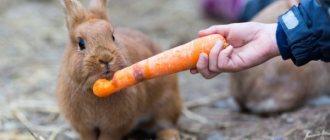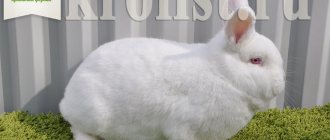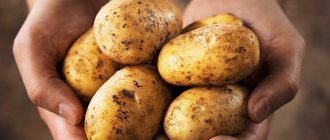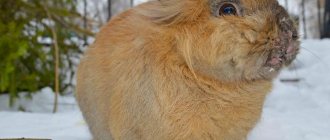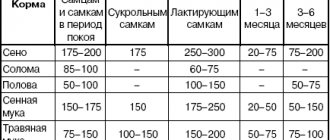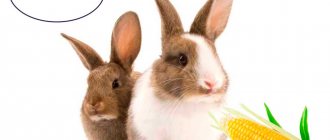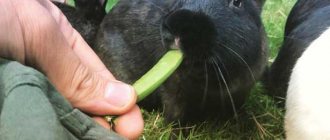Rabbits eat plant foods. They have a relatively large single-chamber stomach. Therefore, they need adequate feeding according to generally accepted standards. However, before compiling a diet, you should familiarize yourself with some of the physiological characteristics of animals.
This article describes the main features of feeding rabbits: a description of food products, examples of diets and food that should never be given to animals.
- Greens
- Diet structure and feeding norms
Why is a proper diet important for pets?
Active growth and weight gain are undoubtedly directly influenced by rabbit food, optimally balanced and properly prepared at home. It also allows you to minimize financial costs.
Fulfillment of all conditions allows us to ensure that an adult rabbit can produce at least 30 rabbits per year. With proper nutrition, young animals reach marketable weight (3.5-4.5 kg) at the age of 4-5 months.
If the diet is prepared correctly, the female becomes capable of the next conception within 3-5 days after the birth of the cubs. To summarize what has been said, it should be said that rabbits need to be constantly fed, fed, and fed again.
Feeding pregnant rabbits
I advise you to pay great attention to the feeding diet of pregnant rabbits and here’s why. If the mother's body lacks nutrients, the normal development of the fetus is delayed. That is why the diet of nursing rabbits should contain both oats and mixed feed, legume grains (80-100 g); As a protein feed, you can add sunflower cake or meal (30-55 g), soybean meal (up to 30 g). Juicy feeds include silage and carrots. Mineral feeds include chalk, bone or meat and bone meal (1-2 g). Don't forget about fish oil (2 g). Before breeding (approximately 5 days in advance), the amount of bulk feed is reduced, and the amount of concentrates required for nutrition is increased.
What to feed rabbits
Optimally balanced feed allows breeders to achieve active growth of rabbits and rapid achievement of reproductive age.
Types and characteristics of feed
The table below lists rabbit food and its components.
| Name | Components |
| Greens | all kinds of herbs |
| Juicy | root vegetables, fruits |
| Rough | varieties of hay, haylage, chaff, branches, needles |
| Cereals | grains of cereals and legumes |
| Concentrates | vitamin flour, cakes, meal, skimmed milk powder |
| Vitamin-containing | yeast, chalk, flour (herbal, pine, bone, fish), table salt |
It makes sense to consider different types of feed separately, paying attention to their beneficial properties.
Green feed
The following plant families are green foods:
- legumes (peas, alfalfa, sainfoin, etc.);
- cereals (barley, oats, etc.);
- umbelliferous (dill, celery, etc.).
This also includes:
- tops of root crops;
- weeds (dandelion, wheatgrass, etc.).
But yarrow, chicory and wormwood have a detrimental effect on the taste of milk in females, causing bitterness. Cubs often refuse such milk.
Greens have a low calorie content, but are rich in useful components. It is dried before serving.
The table lists the main properties of the various components of green food.
| Type of feed | Properties |
| Grass from the beds | source of vitamins and minerals |
| Cereals from the beds | source of vegetable protein, micro- and macroelements |
| Root tops | well absorbed |
| Celery, dill | improve appetite |
| Dandelion, dill | increase milk secretion |
| Parsley | reduces milk supply |
| Nettle, wheatgrass, sow thistle | source of essential chemical elements and vitamins |
| Wormwood, chicory, yarrow | adds bitterness to milk |
| Henbane, hemlock, lily of the valley, ranunculus, celandine | poison for rabbits |
Feeding rabbits these green herbs must be approached with special responsibility. Rodents should definitely be fed with them during the growing season.
Juicy feed
This food consists of 70-90% water. The most favorite foods for pets are the following:
- potatoes - they contain few vitamins, but a lot of quickly digested starch. This root vegetable should be boiled, and given raw only in the form of peelings, and for “future mothers” it is excluded, i.e. It is not recommended to feed them this food;
- carrots are a source of healthy carotenes, vital for breeding rabbits, pregnant/lactating rabbits and growing rabbits. The daily norm for an adult animal is up to half a kilogram, for young animals - starting from 20-30 grams, increasing the portion to 100 grams;
- pumpkin, like carrots, contains many carotenes. In addition, it is easy to store, which allows you to cut it into small slices and include it in your diet all year round;
- fodder/sugar beets – recommended both fresh and boiled in a volume of 50 g per animal. If it is necessary to increase the portion, you should add hay and feed;
- fodder cabbage – helps improve undercoat growth. Boiled, fresh, pickled will do. The daily dose for adults is up to 400 g, during lactation - up to 600 g. Young animals are not fed so plentifully. Raw cabbage should be fed with restrictions, as it causes gas formation in pets;
- Jerusalem artichoke - “both tops and roots” are suitable for food. It is used as a prophylactic agent in the fight against intestinal parasites in breeding objects;
- silage - legumes, tops from root crops, and meadow grasses are used for its production. A well-made silage should not have a putrid odor or mold, with a neutral acidity level. They begin to feed silage from 3 months of age (up to 50 g), increasing the portion size gradually. For individuals weighing 4 kg – up to 300 g, for “future mothers” – 200 g, during lactation – up to 400 g.
- berries and fruits provoke flatulence in eared animals. Therefore, it is better to eat them yourself and give the rabbits vegetables.
The table shows the properties of succulent feed.
| Name | Properties |
| Potato | presence of starch |
| Carrot | presence of carotenes |
| Pumpkin | presence of carotenes |
| Cabbage | improved undercoat growth, likelihood of bloating |
| Jerusalem artichoke | prevention of intestinal diseases |
| Silage | improvement of intestinal microflora |
| Fruits, berries | Causes bloating |
Roughage
This type of food improves intestinal motility in rabbits. In addition, the digestion of dry plant components increases the body temperature of rodents and activates homeostasis in the body.
When a rabbit eats roughage with appetite, its incisors wear down, which is also beneficial for it. So the animals should be fed with similar products in any case.
The following feeds are considered roughage:
- hay. Legume hay contains much more plant protein than grain hay, making it more nutritious. It is necessary to mow hay before flowering or at the very beginning of flowering and feed the rabbits with already dried product;
- haylage This is also hay, but compressed into briquettes. In addition, it is not dried completely;
- straw. Rabbits, and especially female rabbits, love straw, provided it is clean and well dried. The straw is crushed and molasses or a 1% solution of ordinary salt is poured into it;
- branches. Young branches of different tree and shrub species are used. They are dried and brooms are knitted from them. The animals themselves gnaw off what they like, and the leftovers can be thrown away without regret.
The properties of some types of such food are presented in the table.
| Name | Properties |
| Hay | Very nutritious, but inconvenient to use because it crumbles on the floor |
| Haylage | Helps add variety to your diet |
| Straw | Replenishes fiber deficiency in the body |
| Branches | Help pets grind down their incisors. Increase appetite. Improves the quality of fur and meat. Used for medicinal purposes |
Concentrated feed
Feeding rabbits with concentrates is usually done by large farms that may not have enough time or funds to prepare or purchase natural feed.
The following feeds are most often used (separately or mixed):
- oats - contains up to 70% starch, 10.5% fiber, 8.5% protein and 4-8% fat. Can be fed whole, crushed or flattened;
- corn – the calorie content exceeds oats by 1.35 times. Before serving, it is either crushed or soaked, and occasionally boiled.
Animals should not be fed corn alone.
- wheat bran - contains about 60% non-nitrogenous extractive substance, 13-17% protein, 5-10% cellulose and 3-5% fat. First, the bran is slightly moistened and added to natural feed;
- cakes and meals are by-products of the production of vegetable oils, rich in protein (up to 40%) and fats (10%), contain B vitamins, phosphorus and iron. Before serving, crush or steam. Sunflower, flax, soybean and hemp cakes are used. Cotton seed cake is poisonous for pets. Meals are similar to cakes, but have less fat content;
- acorns are very nutritious; they are given to rabbits in small portions as part of the main food, peeled or dried and crushed;
- combined - there are complete, in the form of granules, and non-complete and are produced in bulk. Complete food can provide your pet with all the necessary nutrients. When using non-complete food, he also needs other food. However, it is important to ensure that there is fresh water in the drinking bowls.
The table shows the properties of concentrated feed.
| Name | Properties |
| Oats | Useful for proper functioning of the gastrointestinal tract |
| Corn | Promotes quick saturation |
| Barley | More nutritious than oats. Well absorbed |
| Wheat bran | Due to the presence of microelements, they normalize metabolism |
| Cake and meal | High calorie content, presence of vitamins and microelements |
| Acorns | Useful for neutralizing feed with a laxative effect |
| Compound feed | Capable of fully satisfying the nutritional needs of rabbits. Allow them to administer medications if necessary. |
Vitamin and mineral supplements
A fully balanced diet for rabbits should certainly include basic vitamin elements, such as:
- A – has a positive effect on the functioning of the nervous and reproductive systems in patients, improves their general physical condition;
- B1 – is responsible for the metabolism of carbohydrates in the body, normalizes the activity of the cardiovascular system, indirectly improves the functioning of the gastrointestinal tract;
- B2 – improves the condition of the skin and fur, optimizes the general physical condition of animals;
- B5 – normalizes the functioning of the digestive system;
- B6 – is responsible for the absorption of proteins and simple proteins, as well as the enzymatic balance in the body;
- B12 – promotes the absorption of proteins, is extremely important for the health of newborn rabbits;
- C – strengthens the immune system and normalizes the functioning of the gastrointestinal tract;
- D – necessary for the proper development of the musculoskeletal system of eared animals, promotes better absorption of minerals;
- E – is responsible for the development of the muscular system of pets. Stabilizes the functioning of the heart and reproductive system;
- K is an essential vitamin for rabbit breeding.
However, vitamin supplements should be used with caution. Hypervitaminosis can provoke deterioration of fur, lethargy, and inflammatory processes.
The following foods contain essential vitamins for eared animals:
- A – grass feed, vegetables, fruits;
- B – dairy products, wheat crops, bran, feed and brewer’s yeast, bone/fish meal;
- C – carrots, rose hips, black currants;
- D – fish oil, dairy products;
- E – vegetable fats, corn, wheat.
If the desired effect cannot be achieved through the use of natural products, they resort to multivitamin preparations.
Calcium and phosphorus are the main elements that ensure the normal development of a pet and its ability to reproduce. The substances used are bone ash and flour, table salt and chalk.
In addition, ready-made formulations containing the necessary components are available for sale, namely:
- Bio-iron;
- Carli mineral block;
- Chica mineral stone;
- Ushastik. A complex preparation containing vitamins.
Conditionally permitted types of feed
Some products can be given to eared pets on a limited basis, offering an alternative in the form of proven food.
Vegetables
Feed with caution to animals:
- cucumbers and red beets for their laxative effect;
- turnips, radishes;
- sweet pepper fruits.
Fruits
Juicy fruits and berries are given to pets in small quantities so as not to cause diarrhea. You can give watermelon, melon, strawberries, raspberries, currants, bananas (pulp).
Cereals
Give rye to rabbits with caution. Cereal increases acidity and causes the formation of gases. The share of rye in the feed mixture should not exceed 5%.
Legumes
Peas, lentils, beans are nutritious and easily digestible foods. But for the gentle digestion of animals, this grain is given carefully:
- peas are given only in crushed or pre-soaked form;
- boil red beans, drain the broth;
- Rabbits are reluctant to eat Russian beans due to their large size and hardness.
Compound feed
In the absence of specialized rabbit compound feed, it is allowed to use pork compound feed for fattening animals . Bird mixtures are not given to animals due to the high content of gravel and shell rock in the product. Cow feed contains a lot of salt, so it is also not suitable for feeding rabbits.
Berries
Stone fruits (cherries, sweet cherries, plums, apricots) are given to animals with caution, removing the pit. The nucleolus contains toxic substances that are deadly to animals.
What not to feed rabbits
The table below provides a list of what you still cannot and absolutely should not feed rabbits under any circumstances:
| Name | Components | Consequences |
| Green | Herbs: henbane, lily of the valley, buttercup, spurge, cress, celandine, etc. | Disorders of various body functions, including death |
| Juicy | Fresh cabbage and potatoes, large quantities of legumes | Gastrointestinal dysfunction, bloating |
| Rude | Branches of wild rosemary, elderberry, wolfberry, lilac, bird cherry, stone fruit trees | Disorders of various body systems, including kidney problems |
| Concentrated | Poor quality and expired food | The most different and unpredictable |
In addition, the following foods should not be given:
- any human food;
- mushrooms;
- lots of grain products;
- lots of dairy products;
- rice;
- alcohol.
What not to give to decorative rabbits
All rabbits are herbivores, but some owners are too keen on experiments and include unnecessary, harmful foods in their pet’s menu.
Even plant foods are carefully selected; the stomach of a small animal will not always digest the volume of fiber or hard seeds.
Not allowed for use:
- milk, cottage cheese, butter, kefir and other dairy products (rabbits do not need animal protein even in small quantities);
- meat, poultry, fish;
- young or green potatoes, eggplants, red cabbage, radishes, onions, tomatoes, cucumbers, beets;
- citrus and exotic fruits (grapefruits, mangoes, papaya, oranges, pineapples, avocados and others; apples and pears are best);
- rice, rye, millet, millet;
- legumes (except dry yellow peas);
- unfamiliar and poisonous herbs: dope, lily of the valley, hemlock, spurge, buttercup, larkspur, hellebore, foxglove, crow's eye, henbane, poisonous weed, celandine, nightshade, lumbago, poppy;
- sugar, chocolate, baked goods (cakes, bread, crackers, ice cream, chips).
For furry babies, plants that are mowed near the road, factory, or near the supermarket building will be dangerous. The collected food is thoroughly washed and dried. For treats, it is better to use ready-made ones, which are sold in pet stores.
How to feed rabbits
Any diet for rabbits carries with it the task of ensuring the pet is healthy, gains marketable weight, has an attractive appearance and fertility.
Features of feeding and diet
Medium- and large-sized rabbit breeds require the most varied diet, including the entire range of feeds.
What to feed in winter
For the cold, winter period of the year, I have my own norms and portions, which are given in the table below (per animal per day, g):
| Juicy | Hay | Concentrates | |
| Rabbits in a state of physiological rest | 150 — 200 | 120 — 150 | 50 — 60 |
| In preparation for mating | 150 — 200 | 150 — 200 | 90 — 100 |
| Pregnant female | 200 — 250 | 150 — 200 | 70 — 90 |
| Female during lactation | 300 — 600 | 200 — 250 | 140 — 160 |
What to feed in spring
The spring period is a transitional period, and long-eared animals should be gradually transferred to summer mode. Feeding standards for raised rabbits are determined individually and depend on the weather and the level of activity of the animals.
In cold weather, rodents should be fed higher-calorie foods (vegetables, legumes); in warm weather, they should be fed lighter and more quickly digestible foods.
When the animal is active, it needs to be fed abundantly and, if possible, varied.
What to feed in summer
During the warm summer period of the year, the following feeding rates are suitable (per animal per day, g):
| Greens | Concentrates | |
| Rabbits in a state of physiological rest | 400-500 | 40-50 |
| In preparation for mating | 550-700 | 70-90 |
| Pregnant female | 200-250 | 70-90 |
| Female during lactation | 1000-1200 | 120-150 |
What to feed during the rest period
A passive and undisturbed rabbit does not need to be fed as much as in other conditions. Recommended standards and calculations are given in the tables above.
It only remains to note that excess food in a pet in a state of physiological rest can lead to a condition such as obesity and the following unpleasant consequences:
- male rabbits lose interest in mating;
- decreased sperm quality among producers;
- Female rabbits often experience miscarriages and stillbirths.
What to feed for rapid growth and weight gain
Obviously, to achieve all this, high-calorie foods are required, which rabbits eat with pleasure.
To obtain the desired result, you need to add the following components to the main diet:
- corn cobs, boiled potatoes, tomatoes and cucumbers;
- vegetable tops, except tomato and potato;
- wheat bran;
- sunflower, flax, soybean and meal cakes.
To improve the taste of animal meat, you can additionally feed them bread, cereals, and potato peelings. It is useful to dilute crackers and cereals with milk.
You may like the article about rabbit breeds.
Fur breed nutrition
The main goal of growing such breeds is to obtain thick and warm fluff. Since obtaining fluff of proper quality requires a higher content of amino acids in the feed, all volumes are increased by 20-25%.
How many times a day should rabbits be fed?
According to experts, a rabbit is capable of eating from 30 to 80 times 7/24. At the same time, it is recommended to feed it in farms twice a day, and for home breeding - three times.
It is better to feed at certain times, for example: in summer - at 6, 15 and 19 o'clock, in winter - at 8, 12 and 17 o'clock.
How much and when to give water
Usually, for rodents, the water in the drinking bowl is changed in the morning and evening, but if the air temperature in the summer goes through the roof, then it should be topped up again - during the day.
An adult animal's water consumption ranges from 60 to 130 ml per 1 kg of weight, although a female rabbit can drink more - 250-350 ml/kg.
It must be remembered that when feeding pelleted feed, water consumption increases significantly.
Use of vitamin and mineral supplements during feeding
If the menu is made up of simple and natural products (grains, herbs, vegetables), you cannot do without additional vitamins and minerals. As a mineral supplement for strong bones and teeth, you can give chalk to rabbits by adding it directly to the grain mixture. Instead, they use pieces of limestone, which are simply placed in the cage. Animals are also offered the following as a source of minerals:
- pieces of charcoal;
- clay or expanded clay;
- turf cut from a field.
A mandatory component of the daily menu is table salt. The daily norm is 3–5 g per animal. Excess salt can lead to pet poisoning.
In winter, it is useful to give animals complex vitamins . Water-soluble compounds are used ( Chiktonik, Tetrahydrovit), which are added to drinking water. The course of supplementation with vitamins is 3–6 days, monthly.
Chiktonik
Tetrahydrovit
Nutrition rules for breeding eared animals
Depending on the physiological state of the animals, both the composition of the diet and its quantity change.
At different periods of the animal’s life cycle, the rabbit breeder must provide and organize feeding that corresponds to the physiological phase.
Tables with the relevant standards are described above.
Feeding in summer
Feeding in winter
Diet during preparation for mating
As mentioned above, animal feeding during such a crucial period must be increased. It is advisable to provide them with succulent feed/hay/concentrates - 150-200/150-200/90-100, respectively (in grams).
Feeding pregnant and lactating rabbits
Feeding a pregnant or lactating rabbit requires an even greater increase in the number of servings. Portions of succulent food are increased to 200-250 g, the same amount of hay is left, and the dose of concentrates is reduced to 70-90 g.
Diet with dairy products
Born and growing rabbits get milk from their mother. If a female rabbit dies for some reason, the rabbit breeder must select the optimal milk formula to feed the orphans.
The following are used as a rabbit milk substitute:
- goat or cow's milk;
- factory-produced milk formula for rabbits or kittens.
It is most convenient to feed babies with a pacifier, a large syringe or pipette, or a special feeding device from a pet store.
Milk as such is even harmful to adult animals. Firstly, the animal does not feel the need for this. Secondly, adults, like humans, are not able to digest lactose and milk protein.
Features and rules of feeding young rabbits
The life of a little rabbit consists of four stages, during which its nutritional needs gradually change.
- From birth until two weeks of age, baby rabbits need mother's milk;
- In the period from 2 to 3 weeks, a couple of times a week, the baby rabbits can be fed with dry mixtures from dried grass;
- A month-old animal is already able to eat more solid food. Although 20% of the diet should still be milk. The remaining 80% is all kinds of mash, grass, hay;
- Two-month-olds are separated from their mother and offered dry food, bran, hay, grass, and some vegetables.
Feeding rabbits in winter
Feeding rabbits in winter is aimed at increasing nutritional value, while the amount of roughage and concentrates eaten increases. During the winter cold they need energy.
It is also necessary to adhere to such subtleties of winter feeding of rodents:
- Providing rabbits with constant access to food (especially at night and in the morning). A bunker feeder can help with this, as it will prevent over-consumption of feed.
- There should be clean water in drinking bowls, as this is important for young animals and females. In winter, the water can be heated.
- Feed rabbits food containing fiber, which will have a beneficial effect on the function of the digestive tract.
- When feeding several foods at the same time, concentrates are given first and juicy foods second. Feeding rabbits in winter is completed with the distribution of hay.
Figure 8. Diet for rabbits in winter
Figure 8 shows an example of a winter diet for rabbits. It is not recommended to give food containing carbohydrates - cookies, sugar and other treats. Eating this type of food can cause obesity.
Since dispensing feed and drinking water requires the use of special equipment, we recommend that you watch a video about making a drinking bowl for rabbits with your own hands.
Diet structure and feeding norms
The daily feeding ration for rabbits should include nutrients that can meet the needs of the animals. The greatest need for nutritious feed is experienced by lactating rabbits and young animals, and rabbits need such feed least of all during physiological rest (Figure 9).
You can feed rabbits grass and hay in unlimited quantities, which will not harm the health of the animals. However, the amount of other foods in the diet should correspond to modern scientific feeding standards. It is not recommended to allow a lack or excess of nutrients.
What to feed domestic rabbits
Pets, unlike their wild relatives and those who live on farms, require special care and their own feeding rules.
Diet of decorative pets
The cutest, cutest, active and playful creature is the decorative rabbit.
The table below details a varied diet for rabbits living at home.
| Name | Components |
| Juicy food | White cabbage (a little), zucchini, potatoes (mixed), carrots, pumpkin, beets |
| Green food | Root tops, corn leaves, sprouted oats, certain types of grass, green shoots of legumes (a little) |
| Roughage | Bark, branches of trees and shrubs, grain, grass meal, dried herbs, straw and hay |
| Concentrated feed | Purchased at pet stores |
What not to give to decorative pets
A list of most food products that are harmful and dangerous for such breeds, as well as the possible consequences of their consumption, are collected in the table.
| Name | Consequences |
| Table scraps | Gastrointestinal disorders |
| Dog and cat food | Indigestion |
| Poisonous plants | Poisoning, death |
| Branches of fruit plants | Gastrointestinal tract dysfunction |
| Onions, garlic, mushrooms | Poisoning |
| Dairy products, stale food | Gastrointestinal tract dysfunction |
Feeding lactating rabbits
Feeding lactating rabbits differs from any other feeding of farm animals in that their diet requires the introduction of food that will be distinguished by its juiciness and variety.
The best food will be: in summer - green grass (legumes or cereals); in winter, forb hay, silage, potatoes, roots and tubers.
In the feeding ration, the share of concentrates is increased to 60-70 percent (depending on the nutritional value of the diet). Rabbits happily eat wheat bran, peas, sunflower cake (60-80g), feed yeast (5g), bone meal (3-4g). Feeding rates should be increased from the 20th to the 45th day of lactation. In the end, it is worth noting that for each baby rabbit in winter you need to add 30g of concentrates and 20g of hay; in summer - 25g of concentrates and 60-100g of grass.
How to prepare food
It is better to prepare some types of food for rabbits in advance so that the necessary food or its components are at hand at the right time.
How to make mash
Mash is a treat for rodents. The most popular recipe includes the following ingredients:
- boiled potatoes in their jackets – 1 kg;
- carrots – 1 kg;
- oats – 500 g;
- sprouted wheat – 500 g;
- table salt – 2 teaspoons;
- bran – 300 g;
- chopped hay - 2 handfuls.
Prepared using a blender or other chopper. Animals eat mash better not in the form of porridge, but in the form of cutlets.
How to make silage at home
The best silage is made from melons (without tops), cabbage, corn, young sunflower stalks, potato and tomato tops, soybeans, vetch, root vegetables with tops and various herbs, except nettles.
The technology for making silage for rabbits yourself is as follows.
The ingredients are crushed to fragments no more than 1 cm in length. The resulting mass is placed in a barrel, preferably immediately.
The capacity of the barrel depends on how many rabbits will consume the silage during the time during which it will retain its beneficial properties. If there are not very many rabbits, a 100 liter barrel will do. The maximum capacity of the barrel is 300 liters.
It is recommended to cover the mass with a 5 cm thick layer of sawdust from non-resinous wood. Then it is necessary to seal it. The barrel is covered with clay.
During the ripening process, the silage is monitored to see if any cracks have appeared. If they occur, covering with clay is necessary.
In addition to classical silage, fermentation is used. The finely chopped green mass is placed in a barrel, sprinkling each layer with table salt.
The resulting substrate is compacted until the juice appears and pressed down with a wooden circle, on which a load is placed on top.
During the silage maturation process, the barrels are stored in a moderately warm place and then removed to a cool room.
The best food from manufacturers
Today there are a large number of products on the rabbit food market, but the most popular are the following products:
- “Multigane” for rabbits - the company produces complete, balanced food concentrates based exclusively on natural compounds. The company's products do not contain harmful hormones and antibiotics, therefore they 100% meet modern environmental requirements, while containing all the necessary substances for productive breeds. This food has one of the best price/quality ratios due to the presence in its composition of the optimal amount of vitamins, micro- and macroelements, as well as energy compounds useful for gaining weight.
- Feed&Life PC 92-1/24 is a complex of balanced feed that meets premium standards. They are rich in both vitamins and amino acids necessary for optimal body development. The main distinguishing quality of the company is the development of highly targeted products needed during certain periods of an animal’s life. That is why Feed&Life products satisfy all production needs when raising fur-bearing animals.
- Purina, universal food for rabbits - non-professional extruded food for small and medium-sized farms. It contains all the most important components for the development of animals from birth to maturity. The main highlight of the product is the maximum complete content of nutrients, so the use of food makes it possible to refuse other additives, including vitamin preparations.
- PROVIMI for rabbits - the supplement is based on natural ingredients selected according to the principle of the highest biological susceptibility. That is why even a small amount of this product in the diet of animals makes it possible to improve their immunity, as well as increase the productivity of the farm. In addition, it contains only high-quality plant compounds, so this food can provide rabbits with the healthiest diet possible.
- BNL Grain Free rabbit — grain-free food for animals of all ages. It consists of granular components, the basis of which are field and meadow grasses. Most often, such products are used in winter in all kinds of dry mash. They make it possible to completely eliminate the rabbits’ deficiency in green grass, which helps increase immunity and digestibility of other foods.
Advantages of feed for rabbits
- Manufactured according to recipes recommended by the VNIIKP Research Institute, they meet and exceed GOST standards.
- They are distinguished by their natural composition: they contain high-quality natural components of plant origin, mineral raw materials, as well as vitamins and microelements.
- Stimulate the active appearance of appetite, ensure rapid growth and development of animals.
- Reduce mortality of rabbits.
- They have low consumption and reduce mechanical losses during transportation and distribution into feeders.
- They do not contain pathogenic microorganisms, antibiotics, or growth stimulants.
Water in the diet of rabbits
Rabbits must have water in their diet. If it is deficient, animals will have a decreased appetite, poor digestion of food, and a deterioration in their overall condition. It is especially important to provide constantly filled water for pregnant and lactating rabbits. When feeding, they lose most of the liquid with milk. Growing rabbits also need water.
The amount of water for rabbits will depend on the time of year and the food being fed. In summer, rabbits receive a lot of green and succulent food, so the need for water is not so high. However, given the hot weather, they still need to drink water. During the winter season, rabbits receive mostly dry food and need to drink more. If the water freezes quickly in the cold, then you need to pour it into drinking bowls immediately after eating concentrates. You can pour warm water.
It is necessary to water the rabbits, providing them with water constantly. In the absence of water, female rabbits can eat their offspring.
Effective fattening of rabbits
In order to obtain dietary meat in a short time, it is necessary to take 4-month-old young animals or adults for fattening within a month. In the first ten days after the start of intensive feeding of the animals, the supply of hay is reduced, compensating for it with concentrates.
In the next decade, feed is added that promotes fat growth: barley, oats, corn grain, boiled potatoes with bran. In the last ten days of fattening, they are fed ad libitum so that the animals eat the largest amount of food. Rough food is practically excluded. The main component of the diet is concentrates, but their composition should be changed more often.
Nutrition of decorative breeds
If rabbits are bred not for meat, but for beauty, the feeding process changes somewhat. The diet itself remains approximately the same. It should also include fresh and dried grass, various gifts from vegetable gardens and orchards, animal feed, mineral and vitamin supplements. But you can’t just build a bunker feeder for your pet. He will become fat and will not live long.
Decorative rabbits require a special approach
It is important to maintain a balance between constant chewing and daily nutrient requirements, as well as to control your pet’s body weight. To ensure a natural feeding regime, it is worth purchasing feeder toys for your fluffy, which make it difficult for the animal to access food and force the animal to get it:
To ensure a natural feeding regime, it is worth purchasing feeder toys for your fluffy, which make it difficult for the animal to access food and force the animal to get it:
- balls made of metal wire for grass and pieces of vegetables (hanging and rolling on the floor);
- plastic balls for granulated food;
- “hedgehogs” made from twigs.
The advantage of such feeders is that the rabbit will be busy most of the day, and he will not have time for mischief.
What do rabbits eat at home: vitamins, minerals
It is extremely important for these animals to receive sufficient amounts of vitamins, especially during cold periods. Fish oil is very important for them, which is dosed as follows:
- for babies - 0.5 g per individual;
- for an adult animal - 1.5 g;
- for pregnant and lactating females - 3 g.
Culinary yeast and hay are rich in vitamin E, and it is also found in sprouted grains. And from ordinary chalk, an animal can get a sufficient amount of calcium.
Table salt is very important for animals, which must be given to them in the following ratio:
- babies - 0.5-1 g;
- adults - 1.5 g;
- lactating females - 3 gr.
The digestive tract of rabbits: mistakes of novice farmers
A feature of the digestive tract of animals is the weak muscular walls of the stomach. It is necessary to ensure that the stomach is systematically filled with food and the required amount of water, so that the absorbed food can move into the small intestine, where the food is broken down into amino acids and sugar, and then enters the large intestine, where excess moisture is absorbed into the rabbit’s body.
Therefore, it is necessary to provide the animals with frequent feeding, because they eat about 40 times a day, but in fractional doses. Provide them with clean water and food (the manger should be constantly filled with hay).
Pets are rodents; they must grind down their incisors, which grow throughout their lives. They are provided with food rich in fiber to satisfy the natural need for teeth grinding. The presence of tree branches in the cells will help satisfy the need for frequent meals, enrich the diet with fiber and sharpen the incisors.
The animals are known for their cleanliness; they are wary of spoiled food and will not eat it. If a rabbit inadvertently eats such food, it will result in indigestion for him.
Many novice rabbit breeders are alarmed by another feature of long-eared rabbits - coprophagy (eating droppings). There is no need to immediately clean the animal’s mouth, or assume that the food is of poor quality. This process is vitally important, because in this way difficult-to-digest foods are digested, and the body receives fiber and useful components.
In the cecum of animals, under the influence of bacteria, hay and grass are processed, and subsequently useful substances are excreted along with the droppings. If you prevent eating night droppings, the animals will grow slower, and if you decide to feed the animals, they will stop eating excrement, but will become weaker from disease.
Sometimes animals exhibit the ability to control the amount of food consumed. During lactation, the female eats 4 times more than during rest. The gastrointestinal tract of a female rabbit can change in volume up to 30%.
Green food for rabbits
In the spring, when the grass just begins to turn green and the first shoots appear, green food is vital for animals. Various types of herbs are very useful at this time, and vegetable tops and cabbage also go well in the diet.
For green fodder and food for rabbits, grass is harvested that grows in fields and meadows, but you can grow seeded grass species such as legumes and cereals yourself in a suitable area. The minerals and vitamins they contain are very beneficial for animals, as well as the protein in which these plants are very rich. But for better health, rabbits are given mixtures of these herbs; when eating legumes alone, flatulence occurs.
Profitability of raising rabbits for meat
First you need to determine for what purpose you are getting rabbits. If you are just starting to breed them, then it is more profitable to take well-known local breeds.
The profitability of raising rabbits is determined by several factors (Figure 6):
You need to purchase healthy, active individuals, with a well-fed, well-built body, clean eyes and shiny fur. Animals with elongated heads, floppy ears, sagging backs and bellies, and balding hair are considered unsuitable. You need to take care of the housing for the livestock in advance. For outdoor keeping, cages with two compartments are equipped. Feeders and drinkers are fixed inside. Indoors in winter, cages with double ceilings and thick walls are insulated. Cages can be made of different materials, but there should be no drafts in them
It is important to ensure a constant flow of fresh air and optimal daylight. The cells are arranged in several tiers with a passage between them and moderate lighting. When raising rabbits for meat, the light intensity is reduced for the fattening period.
Then choose a maintenance method that will suit your conditions. If there is not enough space on the site, but there is a basement or cellar, then you can keep animals using the pit method.
Rabbit meat is a quickly digestible, high-quality product containing a lot of protein. It is recommended for children, athletes, women during pregnancy and lactation.
Figure 6. Calculation of the profitability of rabbit breeding
When raising rabbits for meat, profit will be brought by meat breeds with rapid growth, weight gain, good quality products, as well as representatives of the meat-skin direction of productivity.
All carcasses must comply with approved GOSTs and quality standards. After slaughter, carcasses are cleaned of all internal organs except kidneys. The head is separated at the first cervical vertebra, the hind limbs at the hock joint, and the forelimbs at the carpal joint (Figure 7).
Rabbit carcasses are usually divided as follows:
- Cooled - temperature no more than 25 degrees;
- Chilled - from 0 to 4 degrees;
- Ice cream - no more than 8 degrees below zero.
To sell rabbit meat, it must be frozen or refrigerated. It is not allowed to sell carcasses to retail chains if they have the following defects:
- Bone fractures;
- Back fat takes up more than a third of the total length of the carcass;
- Cleaning up bruises or bruises;
- Carcasses that were frozen more than once, after which the color changed (became flesh-colored).
During marking, each carcass is marked with a mark on the outer side of the drumstick: carcasses of the first category are given a round mark, carcasses of the second category are given a square mark, and broiler carcasses have an oval mark. If the carcass does not meet the requirements, a triangular mark is placed on the back. From the video you will learn basic recommendations for fattening rabbits for further sale for meat.
Business plan "rabbit farm"
To benefit from rabbit breeding, a business plan is drawn up that considers the main aspects of rabbit farming. A farmer needs to become an individual entrepreneur, since this form of ownership reduces taxes and makes accounting easier.
Figure 7. Cutting a rabbit carcass
The profitability of raising rabbits for meat is average, since this product is not considered the most popular on the market. Fattening animals for meat as a business includes several preparatory stages.
First of all, you need to select a plot of land. A profitable option would be a plot with a minimum rent. The next step is purchasing cells. By building them yourself, you can save your money. At the third stage, you should purchase rabbits. And also hire an employee who will take care of the animals.
The organization of sales must be thought out before starting the organization of the economy. Clients can be meat markets, supermarkets, and individuals. The skins can be sold to fur studios and private fashion designers.
